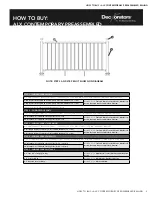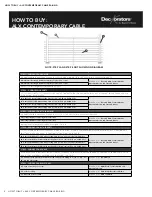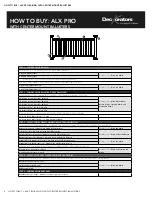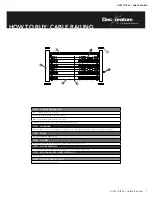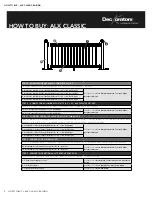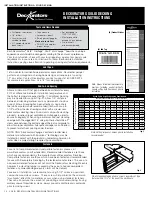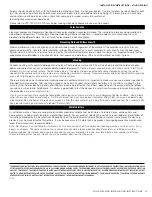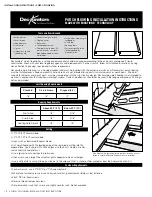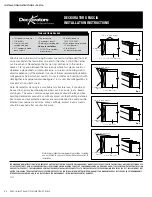
SOLID DECKING INSTALLATION INSTRUCTIONS 13
INSTALLATION INSTRUCTIONS • SOLID DECKING
7903
THE DIAGRAMS AND INSTRUCTIONS IN THIS BROCHURE ARE FOR ILLUSTRATION PURPOSES ONLY AND ARE NOT MEANT TO REPLACE A LICENSED PROFESSIONAL. ANY CONSTRUCTION OR USE
OF THE PRODUCT MUST BE IN ACCORDANCE WITH ALL LOCAL ZONING AND/OR BUILDING CODES. THE CONSUMER ASSUMES ALL RISKS AND LIABILITY ASSOCIATED WITH THE CONSTRUCTION
OR USE OF THIS PRODUCT. THE CONSUMER OR CONTRACTOR SHOULD TAKE ALL NECESSARY STEPS TO ENSURE THE SAFETY OF EVERYONE INVOLVED IN THE PROJECT, INCLUDING, BUT NOT
LIMITED TO, WEARING THE APPROPRIATE SAFETY EQUIPMENT. EXCEPT AS CONTAINED IN THE WRITTEN LIMITED WARRANTY, THE WARRANTOR DOES NOT PROVIDE ANY OTHER WARRANTY,
EITHER EXPRESS OR IMPLIED, AND SHALL NOT BE LIABLE FOR ANY DAMAGES, INCLUDING CONSEQUENTIAL DAMAGES.
©2020 UFP Retail, LLC. All rights reserved. Deckorators is a registered trademark of UFP Industries, LLC.
7903 1/20
Deckorators.com
Mold Inhibitors
Preventing Mold and Mildew Growth
Color Variation
Cleaning
Like most composites, Deckorators Decking will have color variations from piece to piece. This is due to naturally occurring variations in
wood fibers and polymers. Purchasing all required decking material at one time is recommended, as manufacturing runs can
produce slightly different colors. Do not install if color variation is not acceptable.
Mold and mildew can be a nuisance on any exterior building surface, regardless of the material. If the conditions are right, they will
grow on wood, plastic, concrete, metal and other surfaces. Mold formation is most prevalent in consistently wet, shaded areas.
Spores from the natural environment are carried by the wind and commonly land on decks surfaces. It is important to note that the
appearance of mold/mildew is a function of nature, not necessarily a deficiency with any of the material on which it grows.
Periodic washing with soap/mild detergent and water will help remove surface dirt. This will also help prevent the buildup of pollen,
debris and spores that can cause and accelerate mold/mildew growth.
Caution: A pressure washer should not be used to “blast” mold/
mildew or soils from a deck surface. The abrasive nature of the water stream can potentially cause damage by driving the spores
deeper into the material, which may create a more challenging problem to remedy. A pressure washer with a fan-tipped nozzle should be
used only to lightly wet or rinse wood or composite deck surfaces.
There are many deck wash and exterior cleaning products available at retail. It is important to make sure you use a cleaner specifically
intended for your application. After selecting a product, be certain to read, understand and follow all instructions supplied by the
manufacturer. Some cleaning products and inhibitors may be more effective than others, depending on the environmental conditions
your deck is subjected to. Additionally, it is always a good idea to test the cleaner in a small, inconspicuous area prior to applying it to
the entire deck
(www.deckorators.com).
Tips for snow removal: Care should be taken when removing snow from your deck to avoid damaging the deck surface. Use a plastic
snow shovel, one without a metal edge. A stiff push broom can work very well and minimizes lifting. Light snow can be cleared using
a leaf blower. Do not attempt to break up or scrape ice from the deck surface; use ice melt products when needed. No concerns have
been reported using ice melt products labeled “Safe for Pets”.
As with deck washes, there are several mold-inhibitor products available from paint stores, hardware stores, online outlets and
home centers to help prevent long-term mold/mildew growth. For any product selected, be certain to read, understand and follow all
instructions provided by the manufacturer. Depending upon the environmental factors affecting your deck, some preventive cleaning
products may be more effective than others. It may be necessary to try more than one product. For ongoing preventive maintenance,
follow the manufacturer’s recommendation.
Note: Deckorators is not suitable for structural use. It should not be used for primary load-bearing members such as posts, joists,
beams or stringers. The same common-sense precautions should be taken when handling Deckorators as with wood or other
building materials. Dust masks and eye protection devices are recommended to avoid possible irritation from sawdust and chips.
Gloves will help protect hands. Hands should be washed after construction work.
Screws should be driven flush with the Deckorators decking surface. Do not over-tighten. Use two fasteners per deck board at each
joist. For any decking where two boards meet end-to-end over a joist, add additional blocking
(fig. 2). Always pre-drill a pilot hole
and countersink at board ends when using either composite or wood screws. Be careful not
to over-tighten screws near board ends.
Please refer to PFS-TECO RR-0100 for stringer spacing when deck boards are used as stair treads.



